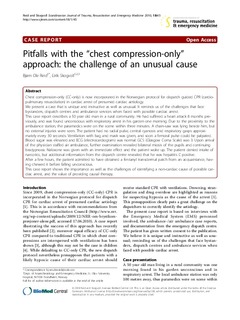| dc.contributor.author | Reid, Bjørn Ole | |
| dc.contributor.author | Skogvoll, Eirik | |
| dc.date.accessioned | 2015-09-25T12:00:43Z | |
| dc.date.accessioned | 2015-10-07T11:47:08Z | |
| dc.date.available | 2015-09-25T12:00:43Z | |
| dc.date.available | 2015-10-07T11:47:08Z | |
| dc.date.issued | 2010 | |
| dc.identifier.citation | Scandinavian Journal of Trauma, Resuscitation and Emergency Medicine 2010, 18 | nb_NO |
| dc.identifier.issn | 1757-7241 | |
| dc.identifier.uri | http://hdl.handle.net/11250/2353171 | |
| dc.description.abstract | Chest compression-only (CC-only) is now incorporated in the Norwegian protocol for dispatch guided CPR (cardiopulmonary
resuscitation) in cardiac arrest of presumed cardiac aetiology.
We present a case that is unique and instructive as well as unusual. It reminds us of the challenges that face
bystanders, dispatch centres and ambulance services when faced with possible cardiac arrest.
This case report describes a 50 year old man in a rural community. He had suffered a heart attack 8 months previously,
and was found unconscious with respiratory arrest in his garden one morning. Due to the proximity to the
ambulance station, the paramedics were on the scene within three minutes. A chain-saw was lying beside him, but
no external injuries were seen. The patient had no radial pulse, central cyanosis and respiratory gasps approximately
every 30 seconds. Ventilation with bag and mask was given, and soon a femoral pulse could be palpated.
Blood sugar was elevated and ECG (electrocardiogram) was normal. GCS (Glasgow Coma Scale) was 3. Upon arrival
of the physician staffed air ambulance, further examination revealed bilateral miosis of the pupils and continuing
bradypnoea. Naloxone was given with an immediate effect and the patient woke up. The patient denied intake of
narcotics, but additional information from the dispatch centre revealed that he was hepatitis C positive.
After a few hours, the patient admitted to have obtained a fentanyl transdermal patch from an acquaintance, having
chewed it before falling unconscious.
This case report shows the importance as well as the challenges of identifying a non-cardiac cause of possible cardiac
arrest, and the value of providing causal therapy. | nb_NO |
| dc.language.iso | eng | nb_NO |
| dc.publisher | BioMed Central | nb_NO |
| dc.title | Pitfalls with the "chest compression-only" approach: the challenge of an unusual cause | nb_NO |
| dc.type | Journal article | nb_NO |
| dc.type | Peer reviewed | en_GB |
| dc.date.updated | 2015-09-25T12:00:43Z | |
| dc.source.volume | 18 | nb_NO |
| dc.source.journal | Scandinavian Journal of Trauma, Resuscitation and Emergency Medicine | nb_NO |
| dc.identifier.doi | 10.1186/1757-7241-18-45 | |
| dc.identifier.cristin | 515853 | |
| dc.description.localcode | © 2010 Reid and Skogvoll; licensee BioMed Central Ltd. This is an Open Access article distributed under the terms of the Creative Commons Attribution License (http://creativecommons.org/licenses/by/2.0), which permits unrestricted use, distribution, and reproduction in any medium, provided the original work is properly cited. | nb_NO |
